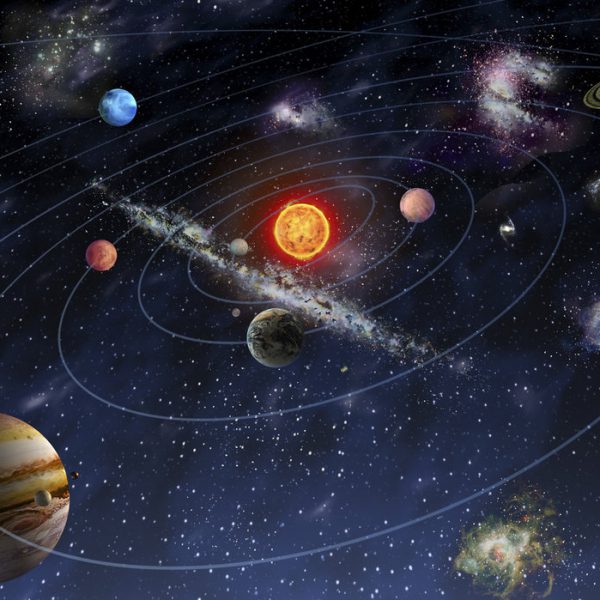A solar system is a system of planets that orbit around the sun, either directly or indirectly. Our solar system is located in the Orion Spur, within the Milky Way Galaxy, which has over 500 solar systems. Our solar system came to being, about 4.5 billion years ago, when a cloud of dust and gas collapsed, resulting in a solar nebula, which formed the solar system.
There are 8 planets that orbit around the sun, which are divided in two categories; Terrestrial and Jovian.

Terrestrial
Terrestrial planets are also knows as the inner planets, which include Mercury, Venus, Earth, and Mars. They are mostly made of rocky material, have a solid surface, don’t have rings, have very few or no moons, and are relatively small.
Jovian
Jovian planets are also know as the outer planets, which include the Gas Giants Jupiter, and Saturn, and the Ice Giants Uranus, and Neptune. The Gas Giants are mainly made of Helium and Hydrogen, and the Ice Giants contain rock, ice, and mix of water, methane, and ammonia.
All Jovian planets have multiple moons, no solid surface, support ring systems, and are immense in size.
Now that you know more about our Solar System, let’s get to know the planets with the solar system more in detail.
Mercury
Let’s start with the smallest and most closest planet to the Sun. Mercury, out of all the planets, orbits the Sun the quickest, within only 3 Earth months. But it spins on it’s axis very slowly, and it doesn’t have a moon.
Venus
Venus is the second farthest planet from the Sun, as well as the hottest planet in our Solar System. It is also the slowest to spin on it’s axis, with 243 earth days. Venus is also knows by two other names, the Morning Star (in the eastern sky), and the Evening Star (in the western sky).
Earth
Now to the third terrestrial plant, our planet Earth. Earth is the only known planet with life on it, as well as the only plant with water. Earth is also sometimes called Venus’ twin. Both planets are almost the same size, have about the same mass.
Mars
Now we’re on the last terrestrial planet in our Solar System, Mars. It is the fourth farthest planet away from the Sun, and the second smallest planet in our Solar System. It is believed that Mars could have had life an eternity ago. Scientist are still studying and wanting to make sure if there is actually a possibility for humans to live on Mars. NASA recently sent a robot, named Rover, to Mars to explore the planet. The Mars Rover drives around the planet and takes pictures and sends them back to NASA.
Now we are done with the four Terrestrial planets, we can move on to the four Jovian planets, which include the Ice Giants and the Gas Giants. Let’s go on with the outer space adventure!
Jupiter
The fifth planet in the solar system, and first of the two Gas Giants, Jupiter is the biggest planet in our Solar System. It is one thousand times (x 1000) the size of Earth. Jupiter has 67 moons, and the main reason for so many moons might be that it has the strongest magnetic field of any planet. It takes a very long time for Jupiter to orbit the Sun, 12 earth years, to be exact. But it only takes 10 hours to spin on it’s axis, which is the fastest of all the planets. Jupiter is also known for it’s red spot, swirling at about 225 miles per hour.
Saturn
Moving on the sixth planet of our Solar System and the second gas giant, Saturn is knows for it’s ring. The ring around Saturn is wide enough to fit the distance from earth to the Moon, but it’s barely a kilometer thick. Saturn is also the second biggest planet and has 62 moons.
Uranus
Now to the first ice giant, and the 7th planet in our Solar System, Uranus. It has at least 27 moons, and is knows for rotating on it’s side, so it’s North and South are on it’s West and East. The tempreture on the planet can go as low as -357ºF. Uranus is the second slowest planet when it comes to spinning on it’s axis, which takes 84 earth years.
Neptune
We move on to the last planet in our Solar Sytem, Neptune, considered the outermost planet in our solar system. It spins the slowest on it’s axis, which takes 165 earth years. However, Neptune wasn’t discovered until 1843, using mathematics. It is the second coldest planet with tempretures as low as -353ºF. Unlike other planets, objects weigh more on planet Neptune, then what they weigh on Earth.

